Genaro Molina is a staff photographer at the LA Times, and a CPOY 74 Stills Division judge. Watch this video to get to know him a little better!
Genaro Molina, CPOY Still Image Judge from CPOY/POYi on Vimeo.
Genaro Molina is a staff photographer at the LA Times, and a CPOY 74 Stills Division judge. Watch this video to get to know him a little better!
Genaro Molina, CPOY Still Image Judge from CPOY/POYi on Vimeo.
Scott Strazzante is a staff photographer at the San Franscisco Chronicle, and one of our still image judges for CPOY 74. Watch this video to get to know him a little better!
Scott Strazzante, CPOY Still Image Judge from CPOY/POYi on Vimeo.
Alexandra Garcia is a producer at the New York Times. Watch the video to get to know her and what she was excited about coming to CPOY this year.
Nick Michael is the Supervising Editor for Video at NPR and was one of our multimedia judges. Watch this video to learn more about him!
Katie Falkenburg, an indepedent filmmaker and photographer, speaks about what she was looking forward to when judging the 74th CPOY competition.
CPOY 74 Judge Adriana Teresa Letorney is the founder and CEO of Visura, a digital platform that specializes in visual storytelling. Watch this video to get to know her a little better!
Adriana Letorney, CPOY Still Image Judge from CPOY/POYi on Vimeo.

Friends and family members of Devonte Ortiz gather on Friday, July 6, 2018, at Pleasant Hills Apartments in Austin, Texas. Witnesses say Ortiz's neighbor Jason Roche fatally shot 19-year-old Ortiz in the early hours of July 4 in a dispute about fireworks.
---
Yanran Huang: What’s the most difficult thing while covering spot news? How do you deal with it?
Lynda Gonzalez: In general, I think the most difficult thing about covering spot news is just not knowing what’s going to happen. And I think also managing a lot of adrenaline, well, also trying to kind of managing a lot of emotions to what’s just happening. Sometimes the setting is very sad and you've got a lot of adrenaline rushing through your body but also... I'm a really empathetic person. You can get filled with grief really quickly if you're covering a funeral or if you're covering something where someone died. So I think the most difficult thing about covering spot news is just managing a lot of physical responses to what you're photographing as well as emotional responses.
I’m a strong believer in getting therapy. I think therapy can give you a lot of the tools to manage in the moment those things that are really difficult. It also has helped me adopt mindfulness practices that I can do while I'm in those moments where I'm just kind of be overwhelmed, which tends to happen when you're having breaking news. And I think grounding yourself and taking a moment to breathe deeply and ground yourself is helpful.
YH: How is your internship in The Dallas Morning News?
LG: I’m really loving it. I’m new to Dallas. The first time I came here really was for this internship. I'm from the central Texas region and I also lived along the south Texas border for a while and so moving to north Texas has been different. But it’s really exciting. It's different culturally and demographically. And also, it’s different just because the sheer size of the D.F.W region (Dallas-Fort Worth-Arlington Metropolitan Area) is massive. It's been really exciting to be here because it's a really happening place, a lot of things happen here in terms of national interest. We have a lot of big events and a lot of big sporting teams as well. It's really cool to be in a city and covering topics that the rest of the nation is also interested and curious about. The photo team here is remarkable and it's really wonderful to work with such a diverse group of people in the newsroom.
YH: Can you get give suggestions to college photojournalist for future?
LG: Some people get this advice a lot, but I really do think it's the best. It's just starting your own backyard. I didn't get an internship my first year at graduate school and everybody else did. I was panicking. I'm going to be so behind. I don't have an internship. It’s so bad on my resume. So the first summer of grad school I stopped in a collective myself and I thought to myself, “Ok, what do you want to be doing.” What I really wanted to do I wanted to go back to the south Texas border and work on my own project that I was interested in. So that's what I did.
I moved back to the border for that summer and I spent my weekends at the beach and during the week I got up – I had a job and I had an internship – and I would work really hard at this project that nobody was telling me to do and I was just curious and interested in. I built a lot of connections in the community along the border and did a photo essay last summer about the colonials in South Texas. Those are a little under developed communities that don't have a lot of access to infrastructure and water services and city services in the city because it's so far out of the city limits. I got to meet a lot of wonderful people and I got to learn a lot more about myself and my own pace without having to be in the formal structure of an internship.
So my advice is if there's a story that you're interested in, just go do it. You don't need any permission to do it. It actually looks better. It's a better reflection of you if you just get up and do it yourself because it shows you're self-starter and you're interested in that theme. It’s the passion come to leading you not because someone comes to tell you go do the story. So that’s my best advice for college students, start doing stories that matter to you because that will reflect really well what you need you find censorship. That will also be the key to unlocking some of the bigger opportunities. So after I did that self-started project. That's what I use to show future editors and that's how I started getting internships because they had a big project that I worked on my own and that was impressive by itself.
As the Stills Division for CPOY73 wrapped up earlier this week, judges headed out as Multimedia judges Maisie Crow, Jarrad Henderson and Yoshi James arrived on Thursday. The Multimedia Division judging will run until Sunday, November 4.
Stills Division judge Marcia Allert, left, speaks with Anto Tavitian, right, during a portfolio review before leaving. (PC: Patrick Farrell)
.jpg)
Still Division judges, from left, Marcia Allert, Patrick Farrell, Vaughn Wallace, and Cheryl Diaz Meyer talk in front of the Columns at the University of Missouri in Columbia.
.jpg)
Multimedia Division judge Jarrad Henderson is interviewed by Ellie Cherryhomes, Jennifer Mosbrucker and Emily Nevils at the start of the judges' arrival on Thursday.
.jpg)
Multimedia Division judge Yoshi James (shown in center) donnes pins of herself and fellow multimedia judges, Maisie Crow, left, and Jarrad Henderson, right, on Friday.

Uwa Iduozee (University of Tampere) Anton Thompson Coon (Arcada University of Applied Sciences) Sandra Itäinen (School of Visual Arts)
Q1. You said that you were doing a photo story for the project, but changed to a video. How did that happen?
One of the first moving images that I took for the project was Leena at the hospital. I took this tripod shot of her just sitting in the chair and just thinking. I just felt it was so much more telling than just a single image because you can see that time passing and the stillness of it all. So many elements could be portrayed in a single image too, but I felt it was stronger by having movements even if it was really minimal. From then, I started adding to that. I don't think there was a single moment where I went, 'No, I have to tell the story through moving images.' I just started using moving images and then I found myself gravitated more and more towards that end.
Q2. How is the still image and video different to you?
I'm interested in telling the stories of people. I've felt with photography, you're always imposing your subjective view on that subject matter. But (with video), given the additional elements of audio or the moving image, I was able to tell and show more aspects of the individual and their life. I was somehow struggling with photography because a lot of times if you're working on a subject like cancer, a lot of the pictures I was taking, I felt they were loaded with my preconceptions and how I understood because I haven't been a cancer survivor.
For me in especially telling portraits of people, video formats give so much more nuances when you're able to add elements and sound. Since then I've been gravitated to more of an observational approach to filming.
Q3. What did you keep in mind while you were filming the project?
Most of the times, I was trying to be respectful and not intrusive. I was also trying to do my best not to impose anything that I expected to get or wanted to get. I was trying to be open to how things are going to unfold, which might not necessarily be exactly how you had envisioned. But I just wanted to be aware of my position and my limited understanding of the issue. I do this with every project. Basically, be open to what happens and go with the direction that's given.
Q4. Your subject looked really comfortable with your presence. How did you do that?
There's a feeling of connection from the start. Of course, you're going to get to know a person, talk about your intention and talk about how you are to get to know each other. But after that, you quickly get a sense of, 'are you on the same wavelength? Do you understand each other? Do you trust each other? Especially do they trust you and your motivations?'
I felt she was really open and she wanted to tell the story. So that was also important. I felt like she wanted me to tell the story. I felt like she trusted me.
And the way that I work is often that the camera is like a safety net. You can hide behind it. I often minimize myself. People don't really forget you, but it doesn't show your presence as much. Or they might forget you for 10 seconds here and there and that ten seconds might be diamond.
Q5. What else did you do to minimize your presence?
You can always say that 'try to act like I'm not here.' But it doesn't work that way. It takes time. I was going back time and time again. By the time I was filming the video, I had already been with her many of times taking pictures so we had already built the relationship. She was also naturally an easygoing person. It also has to do with if the person has something to do. She was reading to her child and they were together. They had the possibility to delve into something other than thinking of my presence in the room. So, I think that's always important. It's much more difficult to get a person to relax or to not acknowledge your presence when they have nothing to do. But when they're doing something, it's always easier.
Q6. Can you give advice to people working on documentary short videos?
Make sure you’re working with a theme you’re passionate about. Be patient in building the trust between yourself and your subject and be open about your intentions to them. Also, nerd out by watching all the docs you can find that in any way relate to your subject matter!
Q&A by Yehyun Kim. Supervising editor is Liv Paggiarino.


CPoY: What impact did winning cPOY have on your work or professional career?
Sleezer: Winning cPOY not only gave me confidence in my chosen career path, but gave me credibility within the photojournalism community. Along with it, came a summer internship at National Geographic when Rich Clarkson was the director of photography at the magazine. I had been following his ability to help and inspire photographers since his days in Topeka, Kansas, and had always wanted to work for him. Having that internship on my resume, along with internships at the Philadelphia Inquirer and Milwaukee Journal helped me decide that newspapers were going to be my chosen career.
CPoY: What is the latest photo project you've been working on?
Sleezer: About 75 percent of the work I do for the Kansas City Star is sports photography. The last project I finished was the 2014 Royals baseball season. My beat is covering the team throughout the season and this year was the first time since 1985 that the team played in the World Series. While a student at Kansas State University in the early to mid 1980s, I was the UPI stringer at the school. This allowed me to hone my skills in sports and news events. One of those skills was turning around photos quickly on deadline for UPI. As technology has changed, I have embraced the technology that allows for quick turnaround of pictures in time for deadline. This skill set is one that is needed today by photojournalists, as newspapers require more and more photos quickly for their websites and social media.
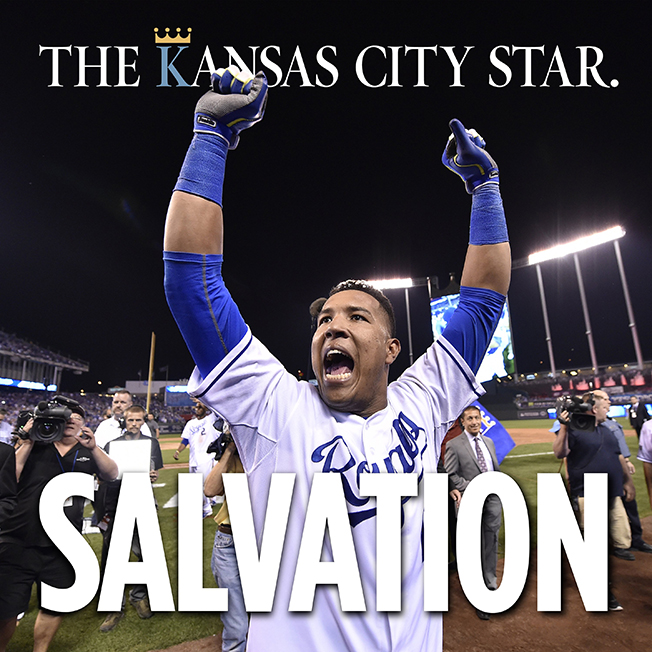
CPoY: Why did you choose and continue to pursue photography?
Sleezer: I chose photography at first because of the process involved. Take the picture and then spend time in the darkroom with chemicals to make the picture appear. The transition to photojournalism for me started as a photographer in the Army in the late 1970s. After photography training and a year at my first post, I was given the opportunity to be assigned to the post newspaper at Ft. Hood, Texas. That exposure to a weekly newspaper, and contact with outside photojournalists coming to the fort, set me on the way to being a newspaper photographer. After the Army in 1980, I stringed and worked for a small daily in Olathe, Kansas, before deciding to attend Kansas State University for a degree in Mass Communication and continue working for the Collegian, a daily student newspaper on campus.
CPoY: How does one develop a personal photographic style?
Sleezer: I've always thought developing a photographic style for a young photographer means studying other peoples styles, and trying to figure out how that photographer makes their pictures. Lighting, lens selection and angle of view, along with how the photographer put themselves in a particular situation, are ways of learning about a photographers style. Copying others styles in different situations helps a photographer to eventually develop their own style. I think that styles change as the situation the photographer puts themselves in change.
CPoY: How has the medium of photography changed for you since entering cPOY?
Sleezer: The skill set that photographers need these days have changed slowly over the years since my CPoY days. Getting wrapped up in the technology and allowing it to dictate how a photographer sees is very dangerous. The end result is the same now as it has always been, a photograph that tells a story about a particular person, event or place, for the public to experience. How we get there has changed, and photographers need to accept the change and see how the technology can add to their story telling.
CPoY: What advice do you have for student-photographers on entering photo contests?
Sleezer: Student photographers should enter and use photo contests to do two things. One, is to help gauge their work against others of similar experience. The photojournalism world is very competitive and it will give them an idea of where improvement is needed and if this is the correct field to spend their lives in. Second, is to further their career opportunities. CPoY on a resume will still open doors but will not automatically guarantee a job. A body of work, including still images, published work, video and participation in social media, will be needed to secure work.
Interview conducted by T.J. Thomson and Alex Scott.
CPoY: What impact did winning cPOY have on your work or professional career?
Buchanan: I have to admit that when I was preparing my portfolio to send in to cPOY, I had been so focused that year on producing a portfolio that would be strong and effective and when I laid it all out on the day before I had to send it in, I was so depressed because I thought “It’s not there.”
But I came to realize that sometimes you can push too hard and you ultimately have to have faith in the work that you are doing and keep pushing forward. It reminded me of the great Ira Glass quote:
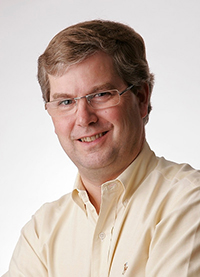
“Nobody tells this to people who are beginners, I wish someone told me. All of us who do creative work, we get into it because we have good taste. But there is this gap. For the first couple years you make stuff, it’s just not that good. It’s trying to be good, it has potential, but it’s not. But your taste, the thing that got you into the game, is still killer. And your taste is why your work disappoints you. A lot of people never get past this phase, they quit. Most people I know who do interesting, creative work went through years of this. We know our work doesn’t have this special thing that we want it to have. We all go through this. And if you are just starting out or you are still in this phase, you gotta know its normal and the most important thing you can do is do a lot of work. Put yourself on a deadline so that every week you will finish one story. It is only by going through a volume of work that you will close that gap, and your work will be as good as your ambitions. And I took longer to figure out how to do this than anyone I’ve ever met. It’s gonna take awhile. It’s normal to take awhile. You’ve just gotta fight your way through.”
Ultimately the CPoY did give me some assurance that I was headed in the right direction and to keep pushing forward and that maybe I wasn’t as bad as I thought at the time.
CPoY: What is the latest photo project you've been working on?
Buchanan: My life is a true variety of work that ranges from editorial to corporate to events and I wish I could say that editorial was still a big part of my business but unfortunately there is less space and pay for it so I am still applying my experience and skills in other directions, but at it’s root, it’s just photojournalism applied to different ends.
This last weekend I was out in LA working with Dan Dry (POY winner back in the late 70s for the Courier-Journal) and working with his team that covers the Breeders’ Cup Thoroughbred World’s Championships, which he and I have covered since the first races in 1984. It’s a test of sports photography, human interest and all on tight deadlines…all the things I still love to this day.
CPoY: Why did you choose and continue to pursue photography?
Buchanan: I love the variety. In everything about photojournalism, there is always something new. And even if there isn’t, it’s up to YOU to find something fresh.
I always admired the staff photographers who were professional enough that even though they were being sent out to photograph the same event that they had photographed time and again, they still came back with something new and innovative. I always vowed that I didn’t want to become one of those photographers that became burned out and bitter and lost the drive to always find something new or fresh. One of my teacher’s, Jack Corn would always say “You’re only as good as your last frame.” Wise words.
CPoY: How does one develop a personal photographic style?
Buchanan: When you start out, you look at others work and try to figure out how they did it. Sometimes you mimic it, sometimes you start to see things from their perspective so, like a piece of clothing, you have to try it on, but it doesn’t necessarily mean it’s your style or you’ll buy it.
You have to take a variety people’s of advice on composition and framing and then start to add your own knowledge of a topic or event and lay that on top of endeavoring to create images that can have more complexity while being simple and straight forward. Balance all those things and you are just beginning to develop a style. A mix of technique, knowledge, insight, and simplicity that combine to make the viewer feel they are right there and a part of the scene; immersed in the scene that they immediately understand it and yet there is more complexity there that they want to study the photo more. Then I think if you are achieving any of these things, you are starting to develop a style that is your own.
CPoY: How has the medium of photography changed for you since entering CPoY?
Buchanan: I think it has changed in some ways: technologically and with some more tools to use, but fundamentally, it’s still about making great photos that grab people’s attention and convey a message quickly, concisely and with depth and conviction.
Yes, it is very immediate and can be around the world in seconds but it can get lost in a lot of chatter. So getting attention for your work can be good and bad.
CPoY: What advice do you have for student-photographers on entering photo contests?
Buchanan: I would say that early in your career it is probably best to go with simple, direct and clean. With time your work will gain more depth and have more complexity. Like young writers who are starting out, their work and success is usually concise, directed and spare of too many words. So maybe your photography should be the same. Direct, concise and not too much clutter and focusing on making photos that put your viewers right in the middle of your images. You can usually succeed with that same formula as a writer.
CPoY: What advice do you have for student photographers/young professionals who are ready to graduate or start in the field?
Buchanan: I recently saw a video interview of Gregory Heisler; his point being that business part of photography and the medium where it is used is always changing that what it was like for me will not be the same as it will be for them. He points out that relationships are important in building a career and also that having a vision of your own to become successful but yet be true to yourself. It’s a great, must see interview.
Always push yourself to find something interesting in whatever you do, no matter how boring or mundane the assignment…and the more you shoot what you know and what you love, it will help you be the best at what you do. Always be curious and want to learn more and it will inform your images and yourself. Remember, you only as good as your last frame…
Interviewed conducted by T.J. Thomson and Alex Scott.
Q. How did you find out about getting a gold medal? What was your first reaction? Club Privé
A. My friend Marcus texted me in the morning (Swedish time) while I was drinking my coffee, and right after that my Facebook started to shout. I didn't understand what was going on, but when I did, I laughed and cried a little. I celebrated with more coffee.
Q. Can you tell us something about making the winning photo?
A. The winning photo is from my long story about Izza and her family. Izza took me to her work, a well-known strippers club in Stockholm, two hours before opening. In the picture, Izza is about to show me the private area, totally aware of me taking up my camera. But the girl to the right—a regular young stripper smoking her cigarette before work—seems to have no interest at all being exposed. This shows the face of two different people in the same world, and even the face of hierarchy. Just a couple of weeks after this picture was taken someone shot at the club and the owners are now forced to leave. So, today my collection of pictures from Club Privé is totally unique.
Q. How did you first get into photography?
A. At first I started taking pictures because of my fear of forgetting things in life. If I got a picture at a moment it was easier to remember. Then later I was supposed to be a journalist, but I didn't have enough patience in writing, so now I’m here.
Q. Who are some photographers who especially inspire you, and why do you admire them?
A. Terry Richardson, because he doesn't give a shit. Also Anton Corbijn because he can make Mick Jagger dress like a woman.
Q. Any tips for other college photographers?
A. A friend that went to another Swedish school of photojournalism told me about when she and her class went to a very poor country in eastern Europe with an assignment to make a picture story. All students came back with rough, sad and tragic stories about poor people, violence and narcotics. Except one girl, who had just photographed beautiful pictures of horses in the countryside. Dare to do what no one expects you to do—and if someone is fighting you about your choices; you're going the right way.
To see more of Susanna’s work, click here.
Interview by Leah Beane and Hany Hawasly
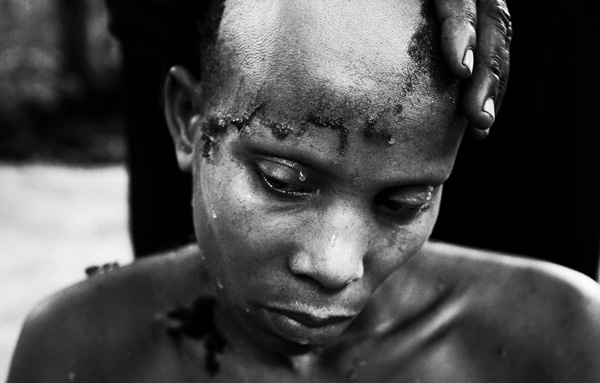
Story: Black Birds
Q. How did you find out about getting a gold medal? What was your first reaction?
A. My good friend called me early in the morning and woke me up with the good news. I was very confused and had a hard time believing that I really won gold!
Q. Can you tell us something about making the winning photos?
A. The story "Black Birds" has been a lot of hard work. I have been struggling to show the atmosphere and the emotions I encountered at the Kalembwana reservation. Many things were centered around superstition and magic and this is what I have been trying to show with my photography.
Q. How did you first get into photography?
A. I have always been very curious of the different ways people live their lives. With the camera, I found out that I could get really close, and that I was allowed to tell intimate stories that I might be able to pass something on to the people looking at my pictures.
Q. Who are some photographers who especially inspire you, and why do you admire them?
A. I spend a lot of time looking at the work of other photographers. It is very interesting to see in how many different ways you can tell a good story. I especially like photographers like Mads Nissen, Anders Petersen and Pep Bonet.
Q. Any tips for other college photographers?
A. I'm still a student and my photography is still young, but what I know is really important to tell a good story is: be curious, be honest and work hard!
To see more of Sofia’s work, click here.
Interview by Leah Beane and Hany Hawasly
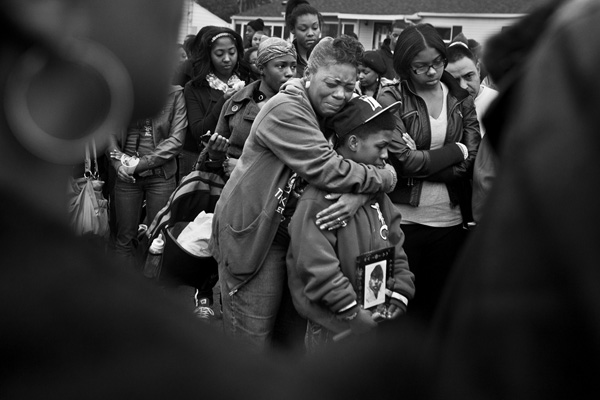
Q. How did you find out about getting a gold medal? What was your first reaction?
A. I was on my way to Flint to visit my old photo editor Jake (ironically where I was interning when I took the winning photo) to talk about portfolio edits when a friend told me. I was in the middle of a traffic detour and I had to pull over until I remembered how to breathe again. When I finally pulled it together, I called Jake to tell him the news. He was so excited when I finally made it to Flint that he picked me up in this huge bear hug and I couldn't stop shaking because I just couldn't believe it.
Q. Can you tell us something about making the winning photo?
A. Working in Flint, we covered a lot of vigils and memorials for victims of homicides and shootings. I remember this one in particular because it seemed to be a random killing. The victim, Laventez, was robbed at gunpoint and then shot. There were over 100 people at his vigil the next day, and upon arriving I could feel the hole that was left in the community after his departure. People were arranged in a circle around Bridget (Laventez's mom) and Laventia (his little brother) as the pastors prayed. I was standing behind the speakers when I watched Bridget grab her son and wrap her arms around him, clutching him as he held on to a photo of his brother. I put up my camera, framing them in between the speakers and took a couple of frames before she let go of him. After the vigil ended, I spoke to her offering her my condolences and thanking her for allowing the reporter and me to come. She thanked me for coming to tell her sons' story before hugging me and then walking away into the crowd of friends and family.
Q. How did you first get into photography?
A. I think I first got into photography because of my dad. It was something both of us enjoyed and bonded over. I grew up in Kentucky on a lot of land, so we would go out and take photos together of little things like the pond and the changing of leaves. We would always get into these contests of who could take the better photo. Eventually, it escalated into a huge passion of mine and a way to express myself and tell stories. Now I pretty much take all the family photos when we are together.
Q. Who are some photographers who especially inspire you, and why do you admire them?
A. I would probably have to say my dad, just because he got me into photography. He doesn't shoot much anymore but he and my mom run a company together and they are pretty much the hardest working people I know. They taught me a lot about working hard to achieve what you want in life and never giving up on your dreams. Even though he's not the greatest photographer and really only takes photos of my family, I think there’s something to be said about personal work and documenting those around you. It's some of the most rewarding work out there and I have him to thank for teaching me that.
Q. Any tips for other college photographers?
A. Hard work and realization. For my first three years studying photojournalism at WKU, I was consistently the bottom of my class. I once even had someone tell me that I should choose a different career path. I think I was just too stubborn to give up on being a photojournalist so I kept at it and kept working. It wasn't until I got an internship with the Flint Journal that I started to make images that I actually liked. I think it took until then for it to click with me that it’s not about me—it’s about this opportunity we all have to share someone's story with the world. When that realization hit, I pushed myself at every assignment I went to, and off the clock, to make the best image I could for each situation and eventually I started to make images that told stories and I think that is one of the most compelling and amazing parts of our industry.
To see more of Sammy Jo’s work, click here.
Interview by Leah Beane and Hany Hawasly
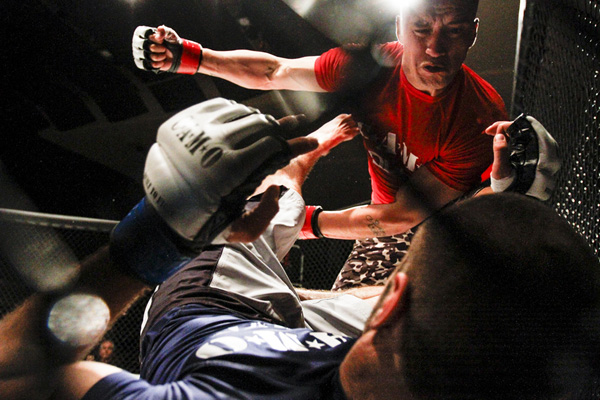
Q. How did you find out about getting a gold medal? What was your first reaction?
A. I was away from school during the middle of the day, so everyone at school found out before me. On my way to class I ran into a friend who congratulated me, and I didn't know what she was talking about. I asked if it had to do with CPOY and she said yeah, but I'll let Kim (Komenich) tell you. When I got to his office he congratulated me and told me I had won. I didn't really believe it. I ended up just pacing around our schools newsroom, unsure what to do with my excitement and energy. My friend James took silver in the same category, which was really cool because we were able to share the excitement of that day.
Q. Can you tell us something about making the winning photo?
A. It was my first time shooting Mixed Martial Arts, so I was a little nervous going into the assignment. Anytime you photograph a new sport there can be a steep learning curve. Luckily for me the access was really good, and there were a number of bouts, so I had time to adapt. The hardest part was anticipating where the fighters would go because the whole time I was shooting through a chain link fence and they move around in all directions. I was in one of the spots I found that I liked when Galvadon connected with Johnson on the other side of the octagon. Johnson stumbled backwards and fell into corner where I was, and I just got as close as I possibly could, lens right up to the fence. I remember checking my shots after the round, I saw this image, and I knew it was the strongest. I just prayed it was going to be sharp enough.
Q. How did you first get into photography?
A. I was junior college taking care of my general education requirements, dabbling in a few random classes every now and then for fun. One semester I realized I was getting close to transferring and I had a lighter schedule, so I decided to take basic photography, black and white film, to try something new, it had always seemed fun. When I transferred at the end of the year, I knew I had found my major.
Q. Who are some photographers who especially inspire you, and why do you admire them?
A. My professor Kim Komenich. I came to San Jose State because I wanted to learn from him. He's photographed it all, seen the highs and lows of our field and the world, and he is still the kindest, friendly, most helpful person. I really admire him for that. He believes in what we do as photojournalists, and that encourages me to always strive for more.
Q. Any tips for other college photographers?
A. Do the things that scare you. Leave no stone unturned. Curiosity is your ally.
Interview by Leah Beane and Hany Hawasly
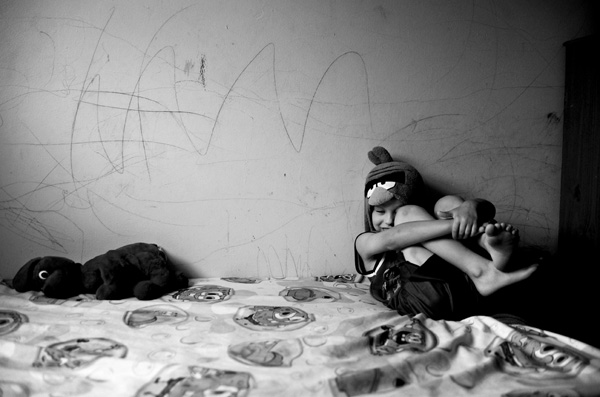
Q. How did you find out about getting a gold medal? What was your first reaction?
A. I wish I could say I was hitting the refresh button constantly on the night of judging, but the truth is my friends began texting me upon their discovery that I had earned a gold metal. When I first found out about earning gold, I was completely speechless. All of the entries my photos were up against were so good, and the other photographers are so talented, so it was mind-blowing to be up there along side of them, let alone earn gold.
Q. Can you tell us something about making the winning photos?
A. When I set out to do that project, the woman and her children that the story was about inspired me. I couldn’t imagine her strength in being a single mother of three with an autistic child, and what it would be like to finally be able to leave public housing. My goal throughout the project wasn’t necessarily to win, but to tell her story the best I could in documenting the incredible change this family was going through. It meant so much to me to have captured the moment of their lives when they entered their new home, let alone lives, for the first time. I was truly humbled in being a part of their experience, even just for an incredibly small fraction of their lives.
Q. How did you first get into photography?
A. Photography was always a hobby of mine. I remember my parents buying me disposable cameras for me to take photographs when I was a child, and then I got my first film camera in high school and learned how to develop film. It was never something I ever felt I could do professionally until college. When I started college, I had no idea what I wanted to do, but I knew I missed the all of the time I spent in high school photographing with my film camera. It was then I transferred during my freshman year of college to Kent State from Miami to pursue a photojournalism degree. I truly love what I have come to learn to do, and now it is all I can see myself doing professionally.
Q. Who are some photographers who especially inspire you, and why do you admire them?
A. I wouldn’t say there is any one specific photographer I admire. I admire many professionals in the field, my teachers and classmates. Their work keeps me going, and makes me strive to become a better photographer.
Q. Any tips for other college photographers?
A. I was once told by one of my teachers in college that there would be a moment when things just “click” and start making sense. At the time, it just seemed like that was impossible. I believe that the moment he was referring to occurs at a different point for everyone. And I guess before that happens, you can truly feel lost, as I did. When I was in my first two years of college, I truly struggled, and had so many problems with story-development and relating what I wanted to say through a limited series of images. Although I still have so much to learn about the craft, I feel as though things began to make sense during my junior year of college. It really took finding something I cared about to find my voice in photography, and to not feel so lost. I would advise other college photographers to keep shooting, despite how discouraging judging and critiques can be. And one thing I always try to remember while I am shooting, is that I need to find a reason for why I am taking pictures of something so I can make others care about what I am saying through my work. At the end of the day, an image will stay with whomever sees it, and what they take away from it is your choice to a certain extent.
To see more of Kristin’s work, click here.
Interview by Leah Beane and Hany Hawasly
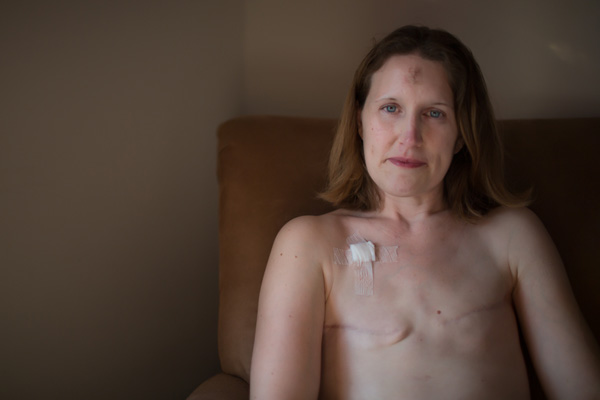
Q. How did you find out about getting a gold medal? What was your first reaction?
A. I found out because one of my friends from class sent me a message on Facebook that said "Jen, did you just win gold for portrait in CPOY?" At first I thought it had to be a joke, I never thought I would win anything. But I looked online and my photo was there! I started jumping around my apartment I was so excited.
Q. Can you tell us something about making the winning photo?
A. I've been working with Leisha for a couple months, mainly focusing on her relationship with her twins. After working with her for awhile I worked up the courage to ask if I could take a portrait of her showing her scars. She was actually really wonderful about it. I guess she knew that eventually I would ask so she prepared herself for it. I read an article about how talking to your subject while you’re taking a portrait can help get genuine emotion in the image. So I talked to her about the boys and how things were going while I shot. I think it helped her feel more comfortable with the situation and it made me feel more comfortable too. I showed her the pictures right after and we talked about how the picture added something really powerful to the story. I really couldn't have asked for a better subject.
Q. How did you first get into photography?
A. My senior year of high school I wanted to take an easy class so I took a black and white photography class. Originally, I wanted to go to school for business but I fell in love with photography in that class. It sounds really corny but ever since I was little I wanted to help people somehow. And photojournalism gave me the opportunity to help people doing what I love to do.
Q. Who are some photographers who especially inspire you, and why do you admire them?
A. There are actually a lot of photographers who inspire me. Eugene Smith, Dave Weatherwax, Chris Capozziello, and my professor William Snyder are all great photographers that I admire. I'm inspired by most photographers, my classmates and colleagues included. I love looking at work because it gives me something to strive for. Especially if I'm working on a story I'll look at stories similar to what I'm doing. It helps give me ideas of how to frame the story and what images will make it stronger.
Q. Any tips for other college photographers?
A. Just don't be afraid of failure. This time last year I was a really terrible photographer, but I just kept working. I still have a long way to go but this is what I love to do so I'm going to work my butt off to do it. Even if you really do poorly one semester or on a big project, it's all learning experience. Also, work on stories that you feel connected to. Don't do a story just because you've seen someone else do it, or you think people will like it. Do your stories for yourself. It'll help you connect on a deeper level with you subject and create something really beautiful. Plus your subject will appreciate your genuine interest and trust you more.
To see more of Jen’s work, click here.
Interview by Leah Beane and Hany Hawasly
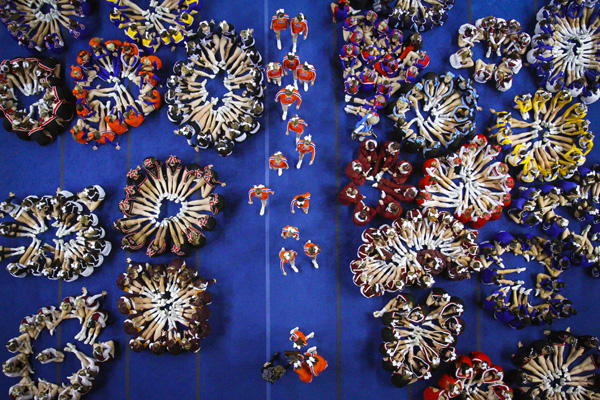
Story: Sports Portfolio
Q. How did you find out about getting a gold medal? What was your first reaction?
A. I first found out while driving to an assignment from a secret Missouri informant who recognized my work. I was incredibly excited and honored! I have been incredibly blessed over the past few years in this contest and the opportunities it has brought me and am incredibly thankful!
Q. Can you tell us something about making the winning photos?
A. The winning portfolio has been a compilation of a lot of hard work. I love shooting sports and the emotion and graphic nature that goes along with it.
Q. How did you first get into photography?
A. I first got into photography when my dad brought home a Pentax k1000 from the Goodwill at the age of 13. I started shooting my little brother’s baseball games, and as I got into high school started making photos for my art classes.
Q. Who are some photographers who especially inspire you, and why do you admire them?
A. I strive to be a mix of Sam Abell and Damon Winter. I love the layering and story telling Sam Abell does and the sterile graphic nature of Damon Winter’s work.
Q. Any tips for other college photographers?
A. My tips would be to study work you admire, shoot things your care about, and never stop working as hard as you can.
To see more of Jabin’s work, click here.
Interview by Leah Beane and Hany Hawasly
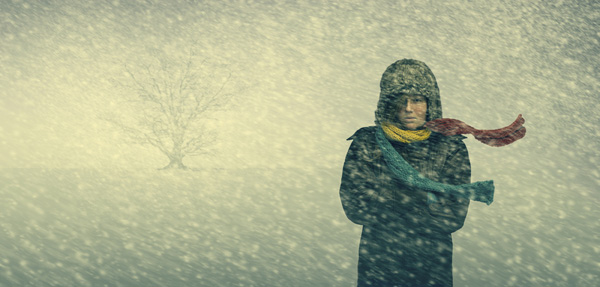
Q. How did you find out about getting a gold medal? What was your first reaction?
A. The morning after the judging my girlfriend Jenna was on Facebook. She asked me if I had won gold with my image? I was confused by this and responded, "What do you mean?" My professor from college had posted on my Facebook page congratulating me about getting the gold medal. It was a huge shock and I had to second guess him for a minute and see if what he posted was actually true. Going onto the CPOY website I then confirmed to my astonishment that I had indeed placed gold. I felt very honored and was thrilled to later find out that I was the first one to represent a medal for Colorado Mountain College.
Q. Can you tell us something about making the winning photo?
A. This was an idea I had conceptualized in my head for a few weeks but couldn't find exactly the right model to capture it. I didn't want the image to come off as a fashion shot. I wanted to convey a bone-chilling storm without drawing too much attention to the model. This image was then shot in a studio on a plain white background. I later used Photoshop to add the snowfall. I used previous images I had photographed of tree branches and combined them to make the tree in the background. I applied different gradients in the image to ground it. This image took less than half an hour to photograph in the studio after I had set up the lighting. But I easily spent over 20 hours in Photoshop to make the image flawless. The image of the girl is a composite of about six images. She was not originally wearing the scarf in the image I selected; I added that later in post.
Q. How did you first get into photography?
A. I grew up in Iowa before I moved to Colorado with my family. I was raised on a farm with my five younger siblings. During this time my brothers and I had to entertain ourselves while our parents took care of the younger ones. We were constantly thinking of new games we could play and things we could build. This led me to develop a creative mind. I was always looking for ways to express my creativity. I was only eight years old when I picked up my first camera. Living on a farm I naturally wanted to photograph animals and nature.This led to my dream about one day becoming a National Geographic photographer.
Q. Who are some photographers who especially inspire you, and why do you admire them?
A. I look up to Aaron Nace as one of my favorite photographers. While I relate to him in some of my conceptual work I am always inspired by the creations he makes with his camera and in Photoshop. I would love to spend just a day with him and learn more Photoshop techniques he uses in making pictures. I would say he really inspires me as a photographer to go wild with my imagination in Photoshop and create images that are beyond this world. He also is a huge reminder to me to stay goofy and have fun while you are photographing. Let's be honest, all of us creative types have a side that is a little silly and weird. So, let it out and use it to help express yourself photographically.
Q. Any tips for other college photographers?
A. I would say don't limit yourself to one type of photography or say what is not for you. I came into college with the idea of becoming a National Geographic photographer and after a few years I have completely shifted my goals and my creative work. I now am a conceptual photographer where a good percent of my work is spent dealing with Photoshop. I never imagined that this would be what I wanted when I first started. So, experiment, try new things, and who knows you may end up liking what you come up with.
To view more of Anthony’s work, click here.
Interview by Leah Beane and Hany Hawasly
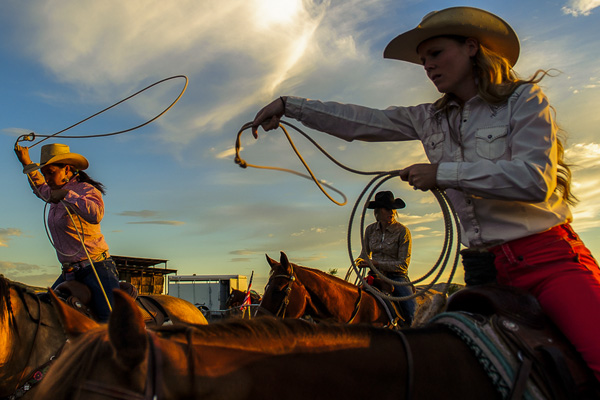
Q. How did you find out about getting a gold medal? What was your first reaction?
A. I found out about receiving the sports feature medal after a couple friends sent me a message to congratulate me. My first reaction was to thank them and then check the site as quickly as possible to see which photo placed. Seeing your picture on the on main winning images screen for the first time is quite exciting.
Q: Can you tell us something about making the winning photo?
A. This particular photo took a lot of patience to make. It involved standing in between a cramped group of horses while trying to piece together all of the photo's layers. I was looking for good separation in the photo, but had to also be aware of my surroundings so that I didn't get knocked down by a horse in the area.
Q: How did you first get into photography?
A. While growing up I spent a lot of my time flipping through skateboard magazines and watching movies. Even before I picked up a camera I recall studying the components that helped to make a piece of work visually compelling. During the summer before my senior year, I took a trip with my parents to Washington DC and visited the Newseum for the first time. On my visit, I viewed an exhibit dedicated to Pulitzer Prize winning photographs, and just by spending some time in that room my eyes were opened to the power a still image can hold. I left Washington a day later with my heart set on becoming a photojournalist.
Q: Who are some photographers who especially inspire you, and why do you admire them?
A. I have focused pretty heavily on shooting sports over the last couple years so photographers like Al Bello have been a huge inspiration. Any sports photographer that is constantly pushing to make new and unique images has my utmost admiration. I also like to look to the work of people like Sam Abell, Bill Allard and Alex Webb. I believe I have drawn quite a bit of inspiration from these three photographers by studying their masterful use of layering, color and light.
Q: Any tips for other college photographers?
A. I think it's important to follow your heart and to tell the stories you truly want to be telling. Set goals and work every single week to achieve them. Also, embrace this awesome community of photographers. Don't ever be afraid to reach out for help and accept that there is always going to be more to learn.
To see more of Alex’s work, click here.
Interview by Leah Beane and Hany Hawasly

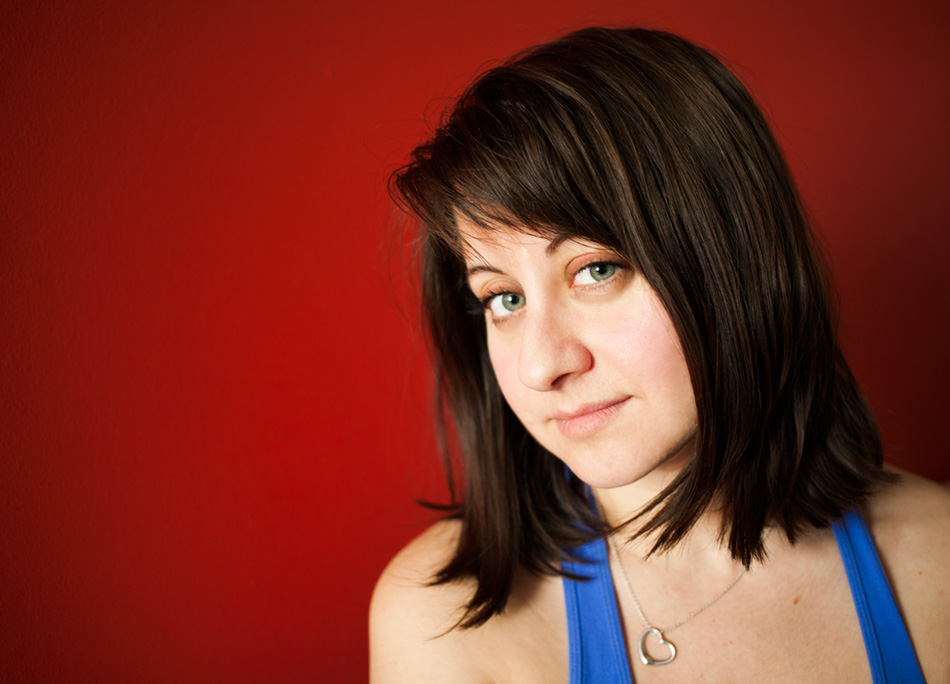
Photo by Melissa Golden
Q. Congratulations on being named the 68th College Photographer of the Year. What does that mean to you?
A. It means that I was lucky enough to be grouped in with some of the best photo students in the world, and then the judges suffered a case of temporary insanity and gave me the gold award. Seriously, the talent and the caliber of work this year was insane. I still can't believe it's actually really happening.
Q. Do you think photojournalism is still needed?
A. Photojournalism is important because it's a useful tool. Photographs are tools that other people can use to engage in discussion and affect real social change, and to foster empathy and understanding. It's also a tool that can be used to inform and encourage further information-seeking. The photos can be used to illustrate serious and often abstract or foreign issues that people sometimes have difficulty grasping at first.
Q. You won two gold medals before the big title, how did you learn about them? What was your first reaction?
A. Actually, I found out both times because people messaged me on Facebook congratulating me. I can't watch those things (the CPOY screencasts), it's too nerve-wracking. I was in Denmark talking at a conference held by the Danish Union of Press Photographers, and I started getting a few messages when my phone picked up wifi. It was very exciting, I'd never even entered CPOY before, I never had the guts. I always used to talk myself out of entering anything, including CPOY. I always sabotaged myself and "forgot" the deadline.
Q. It can't be missed that Shane and Maggie's story got a lot of attention since February, why do you think it made that kind of impact?
A. I think that whenever people see something intimate, something like domestic violence, which is such a private crime, they have a very visceral reaction. I also think that when people look at the photos, they identify with either Maggie, Shane, the kids, or me. Who a person identifies with often says a lot about them. How they react to the photos often says a great deal as well.
Q. What did it take you to pursue and capture the story? Have you ever thought of giving up?
A. The story was originally about recidivism, not domestic violence. Once the story switched gears and became about domestic violence, I was motivated to continue it because I felt that there is a strong need for a story about domestic violence as a process. I also didn't want to only portray Maggie as a victim. I wanted to show her for who she is, and who she is is brave, wise-beyond-her-years, strong, a loving mother…she's a complex, nuanced person, and I felt that simply portraying her as the survivor of this awful event didn't do her justice, nor did it speak to the empowering aspects of her story. I still haven't given up. I talked to her this evening, we're making plans for my next visit when I return to the states.
Q. What projects are you working on recently?
A. I am currently working on two projects while I study in London, one about white Anglo women who convert to Islam, and one about the 25th Anniversary of the Lockerbie bombing. I have a few other ideas I'm playing around with, but for right now I'm trying to quiet my ADHD brain somewhat and focus on these two projects.
Q. Where do you think you're going from here?

A. I'm trying to take it one year at a time, because lord knows I didn't see myself being here this time last year. Things change quickly. If I could continue to do in-depth, intimate storytelling, and expand my skill sets to other arenas of photography/multimedia that will be challenging and rewarding, well, that's the dream, isn't it?
Q. Who are some photographers who especially inspire you, and why do you admire them?
A. I look a lot at the work of my contemporaries and friends, as well as photographers who are well-established. Maisie Crow is a very close friend of mine, and continually blows me away. I love Rineke Dijkstra's portraiture, I love Todd Heisler's storytelling, I love pretty much anything Diana Markosian does. I saw Anastasia Taylor-Lind speak at the same conference in Denmark and was blown away by her skill as a photographer and her intelligence and humor. Donna Ferrato has been an incredible inspiration to me from afar for years, and is now someone who I am lucky to have a real-life friendship with. Melissa Lyttle is someone who just knows how to shoot, without bells or whistles or fancy toning tricks, just incredible access and content and storytelling skills. She just gets it. Pete Muller is doing incredible work in Africa right now. Stephanie Sinclair's work on child brides pretty much sets the gold standard for work that is impactful, broad, and beautifully shot. Eugene Richards is my hero in a lot of ways. Brenda Ann Kenneally. Lynn Johnson. Emillio Morenatti. And hell, just looking through the CPOY winners this year was inspiring (and kind of terrifying). There's so much good work out there. (hence why I don't give a flip about people who say photojournalism is dead).
Q. What would be your advice to college photographers?
A. This is going to sound weird, but stop competing with everyone else around you. I don't mean don't enter contests, contests are fine, and are what they are…but realize they aren't the be-all, end-all. My friend Logan Mock-Bunting wrote this on Facebook the other night:
"Photography is more than exposure and composition and timing. It is about the experiences your subjects+you share, and communicating to others. Those are intangibles that Medals can't be hung on. "Success" will be different for every person."
I completely agree with that. I shot for ten years before I did anything anyone noticed. Of course accolades are nice and can get editors to email you back...but they aren't the way to do good, important work. They wont make further good work magically materialize. Only going out and shooting will.
I spent SO LONG feeling so insecure about my work, and I still struggle with that, except now it motivates me, rather than paralyzes me. That's an important distinction. I was never on the "A" team as an undergrad studying photojournalism, I just wasn't very good. And I let that fact paralyze me for years, I internalized it. I couldn't figure out how to gain access and do photo stories and was convinced I just didn't have that talent. Then I found one story that I've been working on for three years now, and something clicked. And now long form stories are, bar none, my favorite projects (whether in still or multimedia form, doesn't matter).
The best thing I ever learned was to compete primarily with myself, looking at my work over time. To try to shoot better than I did last year. I'm still learning. Having one story and a few awards doesn't make a person bonafied. It just means you shot a good story. A lifetime of dedication does, and that only comes with time. I know it might sound hypocritical coming from me, all I'm saying is that an award is just another tool in your career.
Q. Any final words?
A. There's a really great (and a bit lengthy) Ira Glass quote that says it way better than I can, because, well, he's Ira Glass. So I'll just leave you with that (I know lots of people already know it but whatever, it's still great):
"Nobody tells this to people who are beginners, I wish someone told me. All of us who do creative work, we get into it because we have good taste. But there is this gap. For the first couple years you make stuff, it’s just not that good. It’s trying to be good, it has potential, but it’s not. But your taste, the thing that got you into the game, is still killer. And your taste is why your work disappoints you. A lot of people never get past this phase, they quit. Most people I know who do interesting, creative work went through years of this. We know our work doesn’t have this special thing that we want it to have. We all go through this. And if you are just starting out or you are still in this phase, you gotta know its normal and the most important thing you can do is do a lot of work. Put yourself on a deadline so that every week you will finish one story. It is only by going through a volume of work that you will close that gap, and your work will be as good as your ambitions. And I took longer to figure out how to do this than anyone I’ve ever met. It’s gonna take awhile. It’s normal to take awhile. You’ve just gotta fight your way through.”
Interview by Hany Hawasly
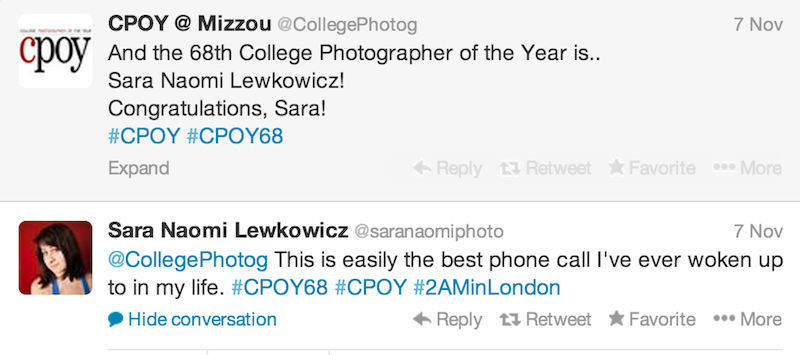

Dedicated to all those who participated in CPOY 68.
"CPOY is a contest by students, for students and of students" - Director Rita Reed


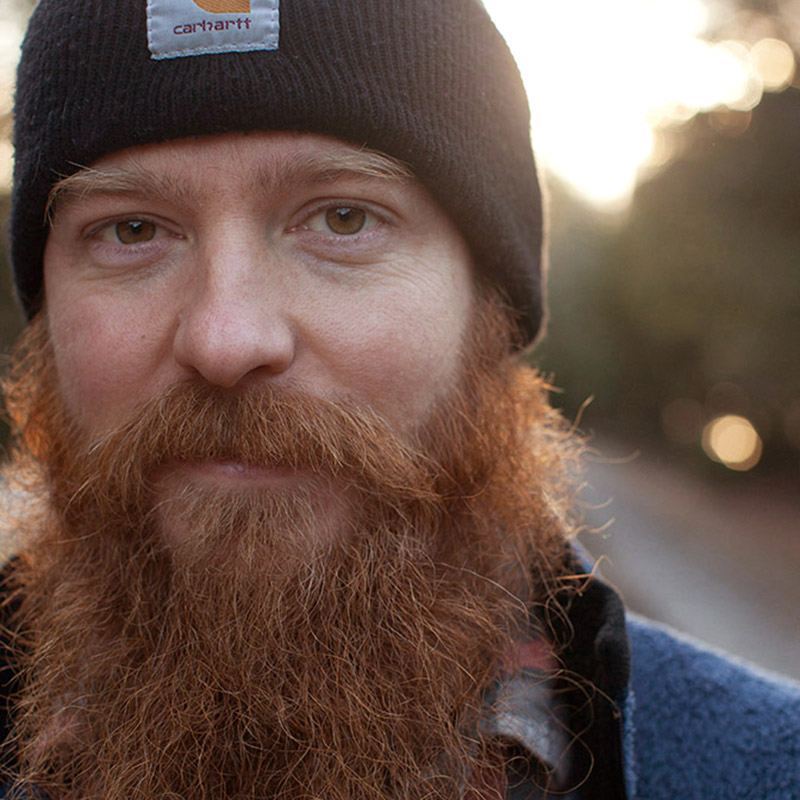
Photo courtesy of Chad Stevens
Chad A. Stevens was named College Photographer of the Year in 1997 while he was a student at Western Kentucky University. He is currently an assistant professor at the University of North Carolina in Chapel Hill, NC and is working on a feature length documentary film on the conflict over energy extraction in Appalachia. Before joining the UNC faculty, he was a documentary producer/editor at MediaStorm. Stevens has also taught in the visual communication programs at Western Kentucky University, the International Center of Photography and Ohio University.
Q. How did you get into photography?
A. I was a nerdy art kid in college. I drew. I painted. I listened to The Cure - only the sad songs, none of that "Friday I'm in Love" business. And I was lucky enough to get a spot in Jack Corn's basic photojournalism course at WKU. Being the darkroom, the smell of the chemicals, learning to see and love light - all of these things and more got me hooked on photography. That's still the greatest gift for me personally actually, just being able to see and appreciate light in my daily life. It brings me a lot of joy.
Q. Do you think winning the competition helped you in your career?
A. Without question, but it wasn't just about my career. Receiving this honor when I did really gave a touch of confidence to keep moving forward, to keep pushing for the next summit. When you are on the journey you just don't know how far you have to go. So it's all about valuing each step and giving yourself credit for how far you have come.
Q. At the time how did it feel to win College Photographer of the Year?
A. I remember every detail of the moment. The phone I answered. The room I was in. The light of the day. Calling my parents after I received the call from CPOY director. It was a pivotal point in my journey, and I'm still very honored to include CPOY on my list of accomplishments.
Q. What would be your advice to current photojournalism students?
A. You have to be human. You have to care. Your compassion and empathy transfers through you - into your work. You are just the medium through which the stories are told.
Present tense storytelling. Be there in the moment. It doesn't matter if you are shooting stills or video, you must be present. Don't' fall into the trap of past-tense storytelling with video. It's the easiest formula to follow, but the easy path is almost always the wrong path. Always challenge yourself. Never settle for what's comfortable. And most importantly, ask yourself what you care about, then find those stories.
Q. Is there anything you would like to add?
A. This may sound just too simple, but here it is: create. You must create. You must continue, even when you can't see what's ahead, you must keep moving forward. Don't let the fear hold you back. That is the only mistake you can make.
Interview by Sarah Rothberg

Q. What advice do you have for any photographer in college?
A. Get close. There are a lot of loose pictures that have pictures inside of them. They’re not breaking people’s personal space; they’re not getting in and shooting. Because you keep that distance and everybody sort of has that distance and wants people to stay out of it. When you start getting in and breaking that space, and getting close to people, your pictures will get better.
Q. On a scale of 1-10, how would you rate the comfort of the chair you’ve been sitting in all day?
A. One! Oh my god. Horrifying. Is that on the list? It just kills your back sitting straight up like that all day.

Q. What advice do you have for any photographer in college?
A. Don’t get discouraged. Keep trying because this is ultimately just the opinion of four people.
I would say (and it goes the same for even professionals, because we get caught in this trap, too) that it’s very easy to put too much stock into contests. Even if it’s something that you’ve seen before and maybe it’s not something you personally have tried to do before, it’s still worth it to try it for the experience.
Q. On a scale of 1-10, how would you rate the comfort of the chair you’ve been sitting in all day?
A. Six. I’m about to start sitting on the floor! It’s nothing personal against the chair; it’s just a desk chair that tends to be very hard to sit in after a while. I’m about to sit on the floor, or possibly lay on the floor, I’m just debating if the floor in there is really as disgusting as I think it might be.
Interview by Shelby Feistner
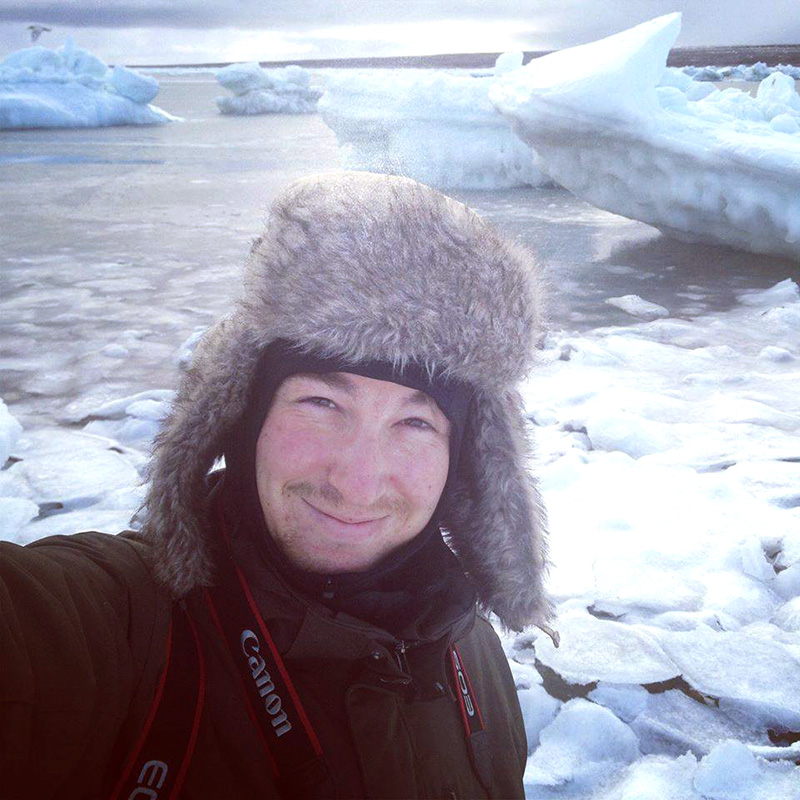
Photo courtesy of Magnus Holm
Magnus Holm was named College Photographer of The Year in 2012 while he was a student at The Danish School of Journalism. He is now interning at National Geographic working on a story about the fast changing culture of the Inuit people in Nunavut, Canada.
Q. Do you think that winning the competition helped you in your career?
A. Winning CPOY meant I got the opportunity of doing the internship at NatGeo which is probably the best thing that has happened for my career. It is an amazing opportunity to learn from the best in the field (both photographers and editors) and for me a very helpful experience in terms of getting to know the field outside of Denmark too.
Q. Do you think that being college photographer of the year influenced your personal approach to photojournalism?
A. I don't think that winning has changed my approach, but it has given me lots of experiences and I have met many interesting and inspiring people through it. I guess you could say it has helped me expand my horizon instead.
Q. What would be your advice to current photojournalism students?
A. I would advise them to go for the stories they find interesting, not what they think other people would have an interest in. It will show in your work.
Interview by Malte Kristiansen

Q. What advice do you have for any photographer in college?
A. Spend time focusing on a project that you’re passionate about, not one that you think some editor or some magazine wants you to work on. That’s the best way to hone your skills, rather than just trying to shoot a lot of things and be a generalist.
Get lots of fine people that will give you honest feedback and get critiques. You get critiques throughout your time here, but then once you leave, it’s good to get it in front of other photographers, share work and get involved with groups that give monthly critiques. Ask for honest feedback and listen. Make sure you’re not so defensive and holding onto your work. If it’s really not speaking to people, move on to another subject.
Be aware of subjects that are so heavily covered by everyone. If you’re going to Burning Man, you will be the one millionth photographer who has made great pictures at Burning Man and you’re not going to distinguish yourself in an editor’s eyes.
Q. Did you have any weird experience coming into Missouri for CPOY?
A. Well, I started in Banff (Mountain Film Festival) and I arrived in Chicago with 15 minutes to spare. I made it, with a little bit of sweat, but my bag didn’t. So I’m wearing the same clothes I wore yesterday, and it was an 11-hour travel day.
Q. On a scale of 1-10, how would you rate the comfort of the chair you’ve been sitting in all day?
A. Since I stand 80 percent of my day at work, I’m going to give it a 4. My butt is becoming one with the chair. I’m not so happy with it anymore.
Interview by Shelby Feistner
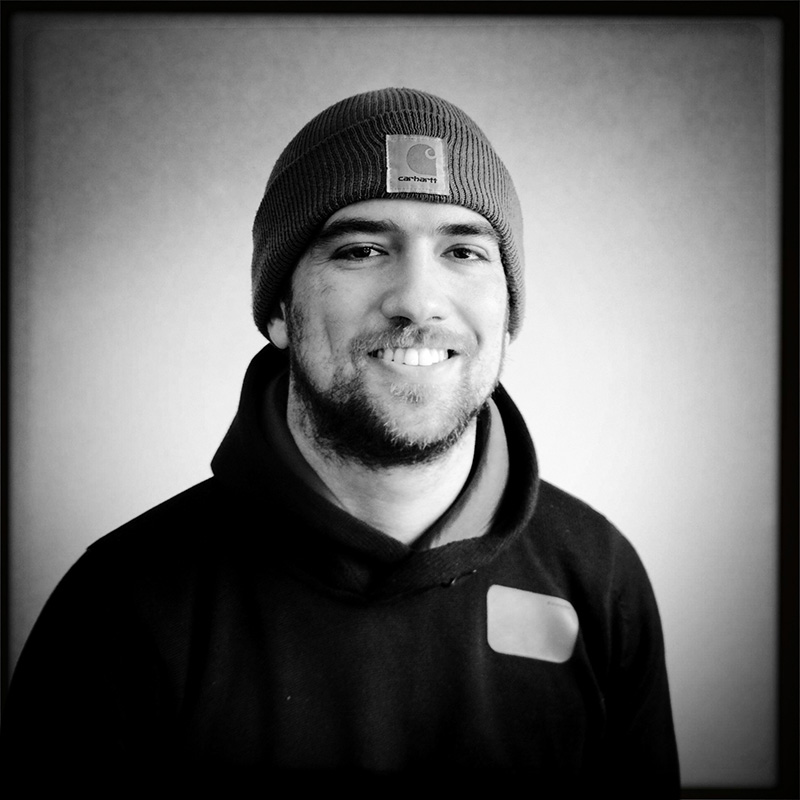
Photo courtesy of Rick Gershon
Rick Gershon was named College Photographer of the Year in 2004 while he was a student at the University of North Texas. He is currently a freelance filmmaker and photographer based in Brooklyn, NY. Previously, he was the director of photography at MediaStorm and a featured photographer with Reportage by Getty Images.
Q. Do you think winning the CPOY competition helped your career?
A. Winning CPOY absolutely helped my career; I would say in many ways it launched it. I was a no-name photographer from a no-name school. I didn't have a big school on my resume or anything at all that would make me stand out for an internship or job for that matter.
Winning CPOY gave me instant recognition and respect. CPOY is a name that is trusted around the world, and so it was pretty huge for me to be recognized by them. Shortly after winning, I was hired on as staff photographer at the Dallas Morning News. I don't think there is any way a 22-year-old with no experience would have been hired on at a paper of that stature without having been recognized like that.
Q. At the time, how did it feel to win CPOY?
A. It was an absolute shock to say the least. I really didn't think I had any chance whatsoever of winning so when I got the call I really didn't believe it. I thought there must have been some kind of mistake.
Getting that call is still one of the coolest moments of my career.
Q. Do you have any advice for current photojournalism students?
A. My advice would be first to seek out a mentor that can teach you how to edit your work in a way that communicates and to learn from them how to speak the visual language. This was by far the most important and long lasting thing I ever did as a young photoj student. Beyond that I would say to keep CPOY or any other competition in perspective, see them for what they are, don't fall into the trap of shooting to win a competition because it's usually not those photographers that win anyways. We are out there in the real world telling real stories — that's what matters. It's great to get praise and respect from your peers and to have your work recognized as great. But always remember the point of why you are doing what you are doing — and that's the people you are photographing and the stories they are so graciously allowing you to tell.
Interview by Alexis Hitt
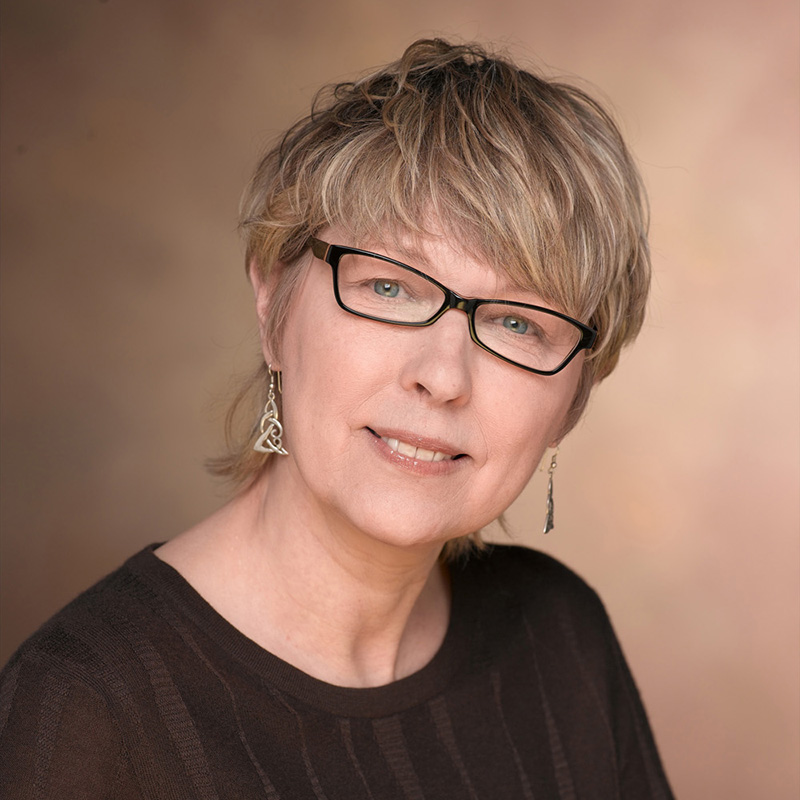
Photo by Mark Thiessen/National Geographic
Sarah Leen was named College Photographer of the Year in 1979 while she was a graduate student at the University of Missouri. She is currently the director of photography at National Geographic Magazine.
Q. Do you think winning the competition helped you in your career?
A. It definitely helped me. That was my first time at National Geographic Magazine and my second internship. I learned how to shoot color transparency film there; I had only shot in black and white until then.
The photographers were so supportive, and I got to go to Africa where I made my first story published in the magazine. It opened me up to what became my future.
Q. What would be your advice to current photojournalism students?
A. It’s a competitive field and there are less places in print to publish stories but there are a lot online. It’s good to have great technical skills, an aesthetic vision and great ideas.
Know what stories you want to tell, what separates the best ones are ideas and the passion to do it one way or another. I would think about what stories I would want to tell. I would focus on my own back yard instead of saying, "I want to go to India because it’s cool." I would find a place that I have a personal connection with. It would give me an advantage.
Q. Is there anything you would like to add?
A. The contest is an opportunity to get your work in front of people. People who are judging might be looking for young talent. If your don’t win one year, you enter again the next year.
Interview by Sarah Rothberg

Q. What advice do you have for any photographer in college?
A. Despite the weird things that you hear about the industry, just be upbeat. Be psyched about choosing something you want to do. Be persistent, get your work out and you’ll do fine.
Q. Did you have any weird experiences coming into Missouri for CPOY?
A. I went to school here twenty years ago. This is my first time back and I had no problems at all. I think I ran over a Jayhawk on the way in from the airport.
Q. On a scale of 1-10, how would you rate the comfort of the chair you’ve been sitting in all day?
A. 8. I haven’t had any pain yet and I feel like I’ve been sitting it all day, but it’s not exactly super comfortable. In fact, I’m jealous of Rita’s chair.
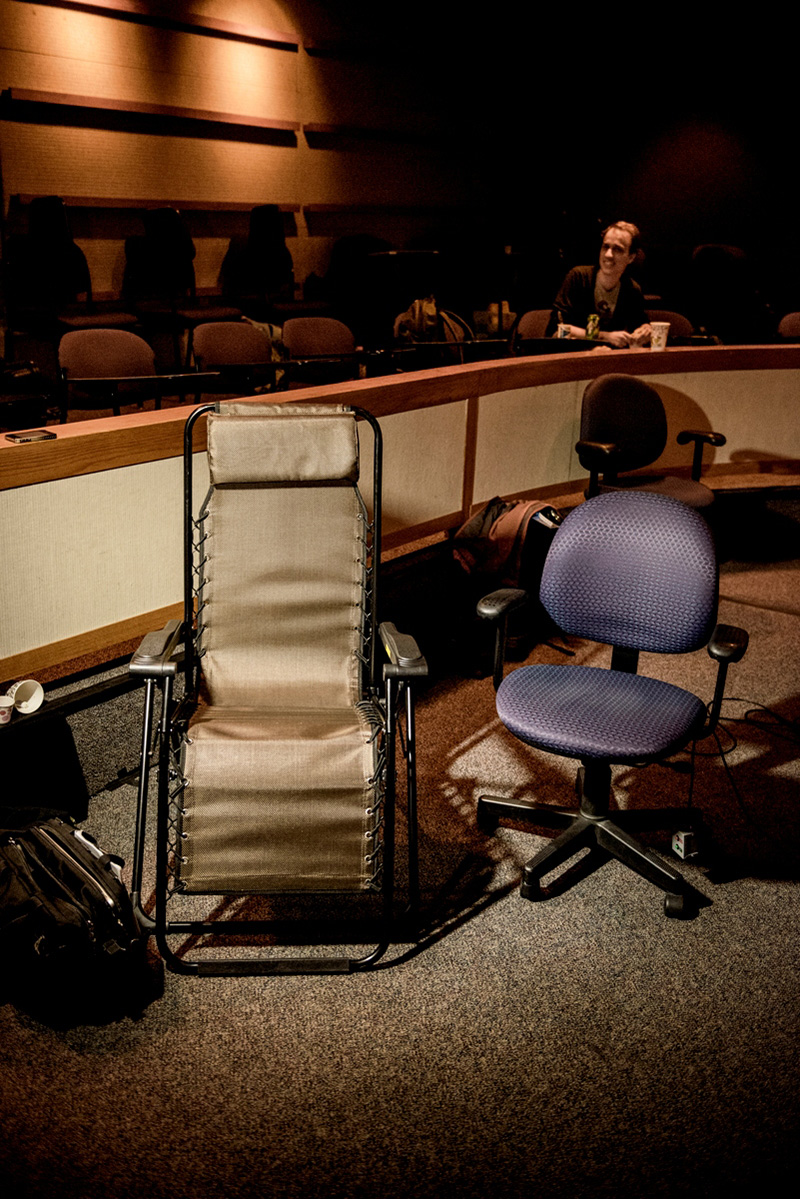
Interview by Shelby Feistner
Photo by Malte Kristiansen




Produced by Brett Slaughter
At 6:45pm on Thursday, November 11, 2010, CPOY Director Rita Reed called this year's College Photographer of the Year, Rachel Mummey, to be the first to congratulate her on the award.





Judge Lara Solt talks about an image that won her an award in the Personal Vision category of CPOY one year.






Steve Rice (Minneapolis Star Tribune). (Video produced by Samantha Clemens).

Travis Fox (Washingtonpost.com). (Video produced by Samantha Clemens).

Melissa Farlow (National Geographic Magazine). (Video produced by Samantha Clemens).

Tammy Lechner (Freelance). (Video produced by Samantha Clemens).

CPOY Director, Rita Reed makes introductory remarks at the start of the 63rd College Photographer of the Year contest. (Video produced by Samantha Clemens).